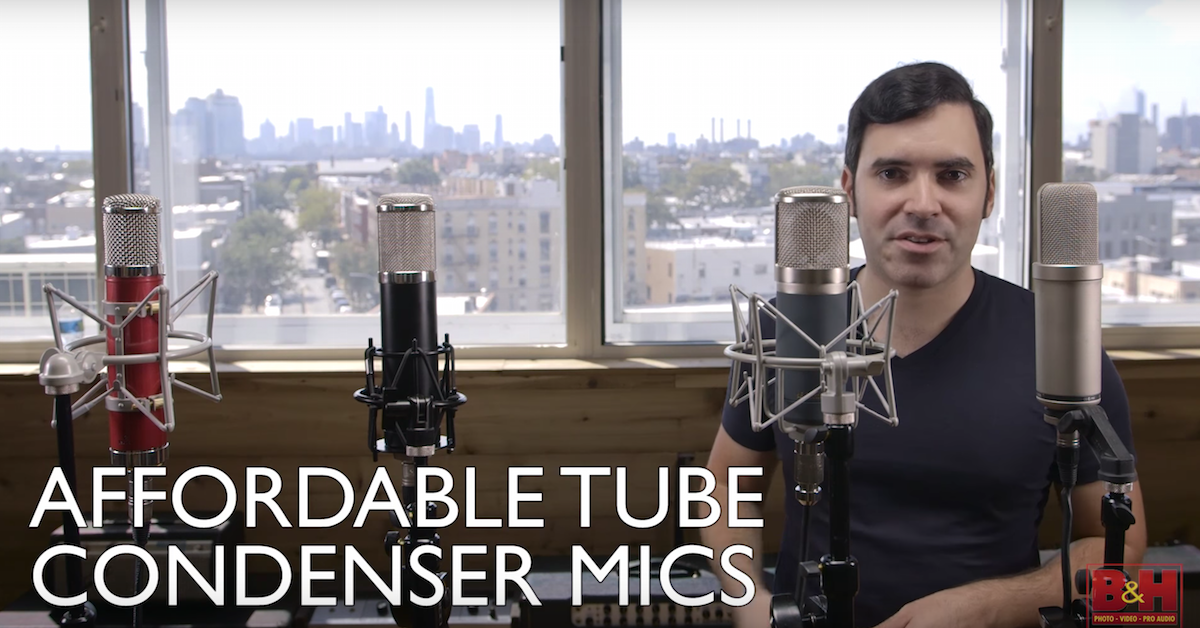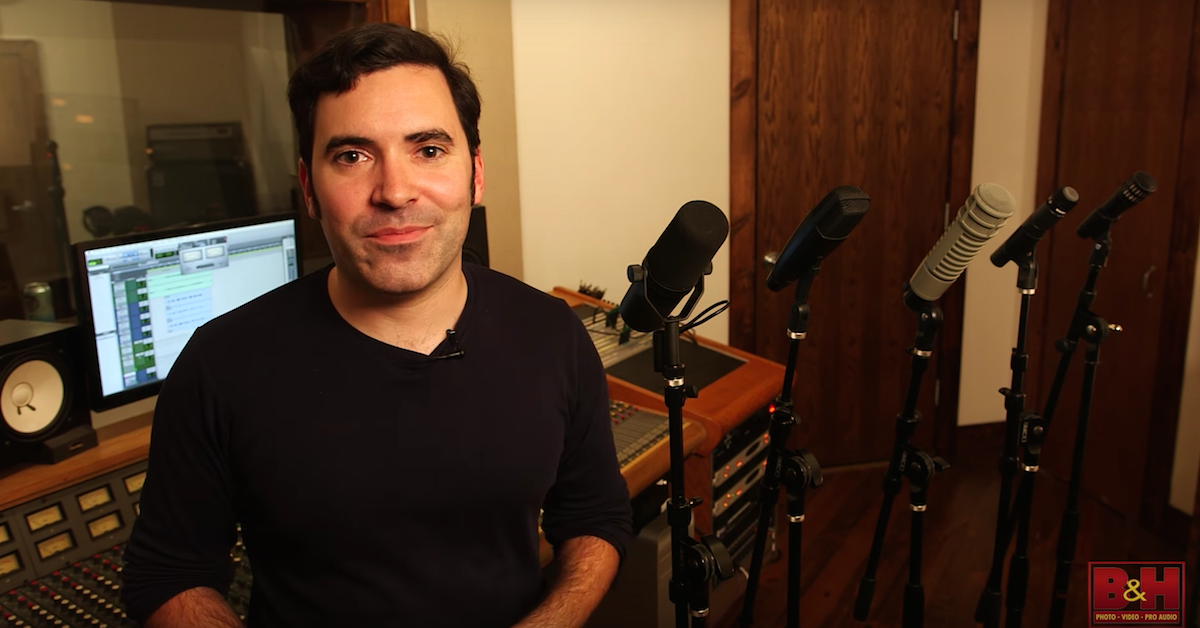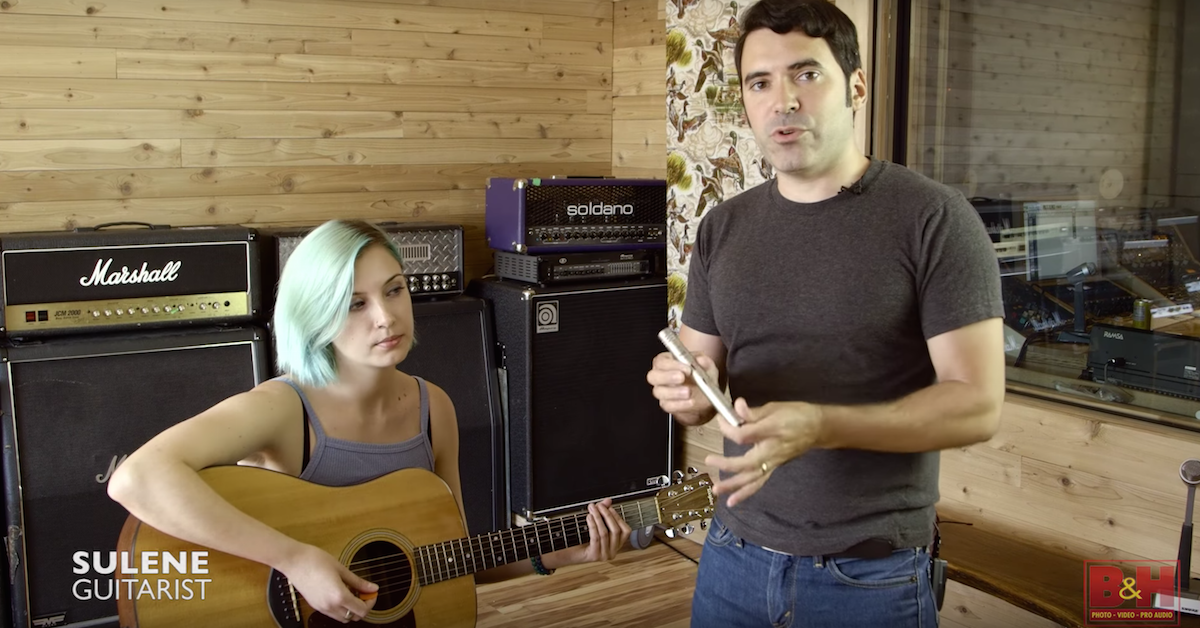Mic Shootout 2: Affordable Large Diaphragm Condensers
Well, last time we looked at mics, they were a thousand dollars and up, and this time, we’re going to look at mics that are between three hundred and a thousand dollars. Mics that are going to become staples of your studio.
We’re here at DeGraw sound. We’ve got once again a great lineup of mics from B&H. Got a really cool musician playing for us all day. His name is Wes Hutchinson, and he will be doing some vocals for us, doing some guitar for us, so we can really get a sense for how these things setup. Let’s get started!
The first mic in our lineup is going to be this Audio Technica 4050, and this Audio Technica 4050 is actually one that the guys from DeGraw sound have had for quite awhile, and it still works and still finds its way into sessions. These are really flexible mics. In a way, like the 414, you kind of put them in front of anything, and they just sound pretty good.
Polar pattern selection here on the front, you’ve got the low frequency roll off and a pad on the back, and it’s just a nice, open sounding mic. We were really impressed by just how good this mic sounded after we had tested all of these super high end mics for the last segment. It still kind of stood up.
I would say it has a bit more maybe of a scooped, softer mid-range character than some of the mics from our last listening session. This can sound great on anything from drum overheads, to male or female vocals, great on acoustic guitar… Any place where you would need an open, clear sound without too much mid-range.
The next mic we’re going to check out is its partner, its brother, its sister, however you want to think of that, the Audio Technica, 4047. The 4047 is similar to the 4050 in some ways. It doesn’t have as much in the way of control. You don’t have polar pattern selection on this one. You do have the low roll offs and the pad on the back, but what you do get in the 4047 is a different tonal character. A little bit more mid-range punch, maybe a bit more reminiscent of the sound of a Neumann microphone and an AKG microphone.
So this 4047, again, really attractive price point on this one, and a slightly different tone than the 4050. Bit more mid-range push I’ve loved on things like male vocals, guitar amps, bass guitar cabs, right in the front of a kick drum, any place that some people would use a classic Neumann FET 47. Great sounding mic at the price. You get to hear this one back to back with a 4050 to kind of hear how their tones differ.
The next one on the lineup here is a Rode NT1000, and this is the least expensive mic we’ve hit so far, but it’s one of my favorite affordable large diaphragm condensers, and one of the favorites of the guys here at DeGraw sound as well.
This one, once again, actually comes from their collection here. If you’re going to spend in the three hundred-ish price range on a microphone, this is a pretty good one to look at. There isn’t a lot of control on this microphone, or really any. I mean, there’s not a single switch or button or knob on the whole thing. It’s just a good sounding, affordable mic that you can put in front of most sources and expect it to sound pretty good.
For an inexpensive mic, I would say it has a fairly smooth sounding character, maybe with a little bit of kind of crisp articulation on the top. It may be a sound that you like. Only one way to found out is by hearing it, and we’ll do that in just a minute.
The next mic on this list is a step up from Rode. This is the Rode NTK. Not much in the way of controls on this microphone, again. It’s just a good sounding, cardioid only microphone like the NT1000. Put it up and it will sound great in front of a lot of sources. This one has its own power supply, because it’s a tube mic.
I would say this one is a little bit brighter than the NT1000, but in a pretty pleasant way. It has a nice mid-range push, a nice extended top end, and if you like a little bit of extra clarity, this can really shine on things like vocals, maybe as a room mic for drums, or a front of kick mic for drums, maybe on acoustic guitar.
This was actually one of the first nice microphones I owned when I was really starting to get into audio and starting to collect gear. I don’t have mine anymore, but a lot of people have held onto theirs, and every once in awhile, I kind of wish I did have it around. Step up from this by Rode would be the Rode K2, which does have the ability to change patterns and some other features, and some folks think even a nicer, smoother sound than the NTK, but you get to hear this one, which is a pretty cool mic at the price.
Even on the brighter end of the spectrum is the Blue Baby Bottle. The Baby Bottle is kind of the introductory mic from Blue. It comes with this pretty cool pop filter that you can mount right on it. It’s a very beautiful looking mic. Really attractive.
I would say it maybe came across as the brightest sounding mic of this group, so if you like bright sounding mics, you might really like this one. Blue is a company that’s making a lot of cool designs, and really interesting looking designs, and some great sounding designs as well.
Enough of me yakking about it. Let’s start hearing these mics, and then we’ll come back and talk about our impressions of the tonal character of each. Let’s dive right in and hear this on some acoustic guitar and some vocals.
[AT4050 on acoustic and vocals]
[AT4047 on acoustic and vocals]
[Rode NT1000 on acoustic and vocals]
[Rode NTK on acoustic and vocals]
[Blue Baby Bottle on acoustic and vocals]
Alright, I’m excited to take it once again to Ben Rice and Gian Stone of DeGraw sound, and hear about their reactions to these mics.
Alright guys, we just heard some really affordable large diaphragm condensers. We had those two Rodes, we had those two Audio Technicas, we got to hear that Blue mic as well. Anything that really stood out for you?
Gian: I really loved the Rode microphone. Those are the first real microphones I got. First large diaphragm condenser that I got.
Justin: Why did you get that mic?
Gian: Because you told me to get that mic. [laughs] Couldn’t afford the U87, so I picked up a Rode, but out of all honesty, like, every time that we put one of those up, I just love the way it sounds. We still use them for room mics on occasion. The NTK, that’s absolutely fantastic, as well as the 4050. That is a fantastic microphone for the price.
Justin: So that NT1000 that we used today, was that one of yours, Ben? Is that one of your Rode mics?
Ben: That was my first actual real mic.
Justin: Cool, what made you choose that one way back then?
Ben: Because a producer that I was working with, who was kind of mentoring me at the time, said get this mic. He actually told me to go to B&H. [laughs] Well, he told me, “Go — you need a microphone, get a condenser mic, this is the one you need to get. Get a mic stand, you can’t hold these, and get an XLR cable, because that’s how you plug it in.”
Justin: And he steered you towards that one?
Ben: Yeah. Because he — I mean, he used those, and I don’t want to give away what records, but he was using it on records that he was doing that were commercially released. This was in the early 2000’s, and they were selling a couple hundred thousand copies, so they were relatively successful records, and he was like, “Dude, this sounds great. Don’t blow your money.”
He was the inspiration, but he was always about get good, affordable gear. Don’t be caught up in the name of whatever this is. Make good sounding records with what you have in front of you, and now I definitely try to take it to heart. But I think the NT1000 is an awesome mic. I used that for years as a vocal mic, drum overheads, from rooms, put it on acoustic guitar.
Justin: For awhile, one I recommended to a lot of clients as well was one of the only really nice sounding mics in its price range for awhile. Probably more competition now as years have gone on, but did it still hold up to you? Did it still strike you as one of the cooler ones from this particular lineup?
Ben: Definitely.
Justin: Anything else that really stuck out to you? Were you also liking the NTK, or was there another one that you’d choose to be one of the best of this bunch?
Ben: I liked the 4050 too. I mean, the 4050 to me is a little bit more like, “open” sounding. Maybe that means the Rode feels a little bit vibey-er to me.
Justin: Maybe the Audio Technica is a little more hi-fi in a sense. That 4050.
Ben: Totally. I would agree with that. But I mean, I think both of those mics are awesome, awesome microphones.
Justin: What do you guys find yourselves using your 4050 on? We actually used your 4050 today.
Gian: Occasionally, we use it as a front of kick drum mic. Just to kind of blow it out. It’s cool. I used it on backing vocals pretty recently. I was having a sibilance issue with the singer, so I was just kind of throwing up every mic we had to see what worked best, and it sounded great.
Ben: I used to use it on bass amps and guitar amps. I think you were talking about using your 4047 for that.
Justin: 4047, yeah, on guitar amps and bass amps, particularly, because that one has a bit more of that mid-range that the 4050 is maybe cleaned out in the mid-range particularly. The 4047 kind of pushes it forward a little bit, and it just works in all of those places you would put a FET 47. In front of a kick drum, in front of the bass amp, in front of a guitar amp.
You know, one of my secret weapons was the 4047 on one speaker of a guitar amp mixed with a dynamic mic on the other speaker, but really cool fun combo.
Well, thanks for sharing your take on this one. Let’s go hear some more mics, and we’ll come back here in a few and we’ll talk about dynamics!
Alright, thanks for hanging out with us and listening to some really affordable large diaphragm condenser microphones. I think any one of these would be a great addition to your arsenal. It really comes down to which one suits your taste the most.
Check these out and more at B&H. Also check out Wes Hutchinson’s work. He has a new album out very recently that I think you will dig if you dig the samples we were listening to today. Remember to check out the other segments on some of the most useful mics money can buy, as well as one coming up very soon on dynamic microphones.
Thanks again to B&H, thanks again to DeGraw Sound, thanks again to Wes Hutchinson. This has been a lot of fun. I look forward to seeing you next time!






